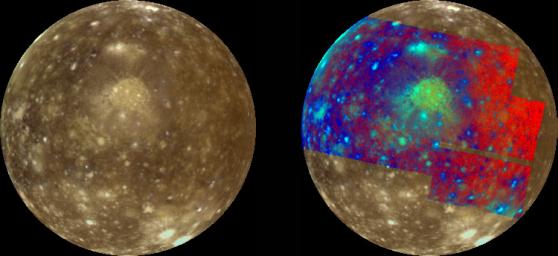Global Color Variations on Callisto
Caption:
Jupiter's icy moon Callisto is shown in approximate natural color (left) and in false color to enhance subtle color variations (right). This image of Callisto's Jupiter-facing hemisphere shows the ancient, multi-ring impact structure Valhalla just above the center of the image. Valhalla, possibly created by a large asteroid or comet which impacted Callisto, is the largest surface feature on this icy moon. Valhalla consists of a bright inner region, about 600 kilometers (360 miles) in diameter surrounded by concentric rings 3000 to 4000 kilometers (1800-2500 miles) in diameter. The bright central plains were possibly created by the excavation and ejection of "cleaner" ice from beneath the surface, with a fluid-like mass (impact melt) filling the crater bowl after impact. The concentric rings are fractures in the crust resulting from the impact.
The false color in the right image shows new information, including ejecta from relatively recent craters, which are often not apparent in the natural color image. The color also reveals a gradual variation across the moon's hemisphere, perhaps due to implantation of materials onto the surface from space.
These color images were obtained with the 1 micrometer (infrared), green, and violet filters of the Solid State Imaging (SSI) system on NASA's Galileo spacecraft. The false color is created from ratios of infrared/violet and its inverse (violet/infrared) which are then combined so the infrared/violet, green, and violet/infrared are assigned to red, green, and blue in a composite product.
North is to the top of the picture and the sun illuminates the surface from near the center, in the same way a full moon is seen from Earth when illuminated by the sun. The image, centered at 0.5 degrees south latitude and 56.3 degrees longitude, covers an area about 4800 by 4800 kilometers. The resolution is 14 kilometers per picture element. The images were taken on November 5, 1997 at a range of 68,400 kilometers (41,000 miles) during Galileo's eleventh orbit of Jupiter.
Background Info:
The Jet Propulsion Laboratory, Pasadena, CA manages the Galileo mission for NASA's Office of Space Science, Washington, DC. JPL is an operating division of California Institute of Technology (Caltech).
This image and other images and data received from Galileo are posted on the World Wide Web, on the Galileo mission home page at URL http://galileo.jpl.nasa.gov. Background information and educational context for the images can be found at
http://www.jpl.nasa.gov/galileo/sepo
.
Cataloging Keywords:
| Name |
Value |
Additional Values |
| Target |
Callisto |
Jupiter |
| System |
Jupiter |
|
| Target Type |
Satellite |
Planet |
| Mission |
Galileo |
|
| Instrument Host |
Galileo Orbiter |
|
| Host Type |
Orbiter |
|
| Instrument |
Solid-State Imaging (SSI) |
|
| Detector |
|
|
| Extra Keywords |
Asteroid, Color, Comet, Crater, Impact, Infrared |
| Acquisition Date |
|
| Release Date |
1998-05-08 |
| Date in Caption |
1997-11-05 |
|
| Image Credit |
NASA/JPL/University of Arizona |
| Source |
photojournal.jpl.nasa.gov/catalog/PIA01298 |
| Identifier |
PIA01298 |

 Planetary Data System
Planetary Data System
